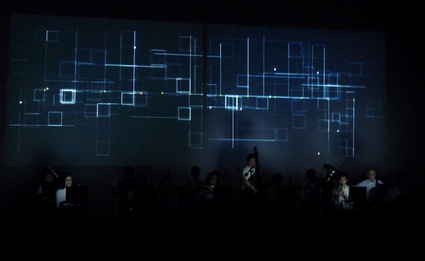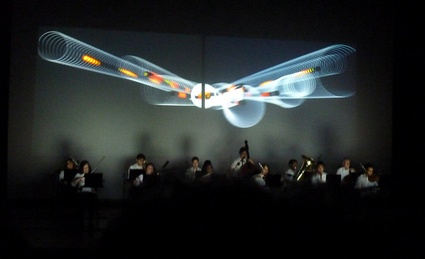Aug 26, 2010
Heart Chamber Orchestra
The Heart Chamber Orchestra consists of classical musicians who use their heartbeats to control a computer composition and visualization environment. To my best knowledge, this is the first example of "group biofeedback".
The musicians are equipped with ECG (electrocardiogram) sensors. A computer monitors and analyzes the state of these 12 hearts in real time. The acquired information is used to compose a musical score with the aid of computer software. It is a living score dependent on the state of the hearts.


While the musicians are playing, their heartbeats influence and change the composition and vice versa. The musicians and the electronic composition are linked via the hearts in a circular motion, a feedback structure. The emerging music evolves entirely during the performance.
The resulting music is the expression of this process and of an organism forming itself from the circular interplay of the individual musicians and the machine.
The sensor network consists of 12 individual sensors; each one is fitted onto the body of a musician. A computer receives the heartbeat data. Software analyzes the data and generates via different algorithms the real-time musical score for the musicians, the electronic sounds and the computer graphic visualization
Below is a video documentation from the Heart Chamber Orchestra performance on the 28th of March 2010 at Kiasma Theatre at Pixelache Festival in Helsinki, Finland.
20:02 Posted in Biofeedback & neurofeedback, Creativity and computers, Cyberart | Permalink | Comments (0) | Tags: biofeedback, heart chamber orchestra, creativity
Dec 20, 2009
Head Chaise: Couching One's Thoughts into a Brain Wave Sofa
From Scientific American
Two European designers, Dries Verbruggen and Lucas Maassen used their alpha waves as a source of inspiration for their design work, which resulted in a piece of furniture, the Brain Wave Couch.
“The process is a wink to a rather futuristic design process,” the couch creators wrote in a press release, “for which a designer merely has to close his or her eyes, or merely rest, to have the brain do all the work, and create the data needed to have the CNC machine cut the shape of the sofa.”
The x-axis of the couch represents Maassen’s brain waves in hertz, while the y-axis shows the amount of alpha activity as a percentage, and the z-axis is the time in milliseconds. Once the foam core of the sofa was completed, the designers covered it by hand in soft gray felt and decorated the valleys of the brain waves with buttons.
The Brainwave Sofa was presented at the Bits ‘n Pieces Exhibition in New York.

20:44 Posted in Biofeedback & neurofeedback, Creativity and computers | Permalink | Comments (0) | Tags: brain-computer interface, neurofeedback, creativity
Oct 10, 2009
Nokia N900 hacks
Enjoy
15:22 Posted in Creativity and computers | Permalink | Comments (0) | Tags: creativity, nokia n900, hacking
Jun 26, 2009
Reactable
From the Reactable website:
The Reactable is a revolutionary new electronic musical instrument designed to create and perform the music of today and tomorrow. It combines state of the art technologies with a simple and intuitive design, which enables musicians to experiment with sound, change its structure, control its parameters and be creative in a direct and refreshing way, unlike anything you have ever known before.
The Reactable uses a so called tangible interface, where the musician controls the system by manipulating tangible objects. The instrument is based on a translucent and luminous round table, and by putting these pucks on the Reactable surface, by turning them and connecting them to each other, performers can combine different elements like synthesizers, effects, sample loops or control elements in order to create a unique and flexible composition.
As soon as any puck is placed on the surface, it is illuminated and starts to interact with the other neighboring pucks, according to their positions and proximity. These interactions are visible on the table surface which acts as a screen, giving instant feedback about what is currently going on in the Reactable turning music into something visible and tangible.
Additionally, performers can also change the behavior of the objects by touching and interacting with the table surface, and because the Reactable technology is “multi-touch”, there is not limit to the number of fingers that can be used simultaneously. As a matter of fact, the Reactable was specially designed so that it could also be used by several performers at the same time, thus opening up a whole new universe of pedagogical, entertaining and creative possibilities with its collaborative and multi-user capabilities
20:09 Posted in Creativity and computers, Future interfaces | Permalink | Comments (0) | Tags: creativity, music, future interfaces
Jun 09, 2009
Google Wave
Google Wave is a new tool for communication and collaboration on the web, coming later this year. A "wave" is equal parts conversation and document, where people can communicate and work together with richly formatted text, photos, videos, maps, and more. In Google Wave you create a wave and add people to it. Everyone on your wave can use richly formatted text, photos, gadgets, and even feeds from other sources on the web. They can insert a reply or edit the wave directly. It's concurrent rich-text editing, where you see on your screen nearly instantly what your fellow collaborators are typing in your wave. That means Google Wave is just as well suited for quick messages as for persistent content — it allows for both collaboration and communication. You can also use "playback" to rewind the wave and see how it evolved.
Watch the demo video below
15:52 Posted in Creativity and computers | Permalink | Comments (0) | Tags: computer supported collaborative work, creativity
Oct 19, 2005
Special Issue of Virtual Reality Journal
A special issue of the journal Virtual Reality will be devoted to the use of Collaborative virtual environments to support creativity. Here is an excerpt from the journals' call for papers:
Creative processes often are collaborative in nature, with a group of people reflecting on an overall theme, jointly contributing thoughts interactively, and ultimately generating new ideas. Collaborative virtual environments (CVEs) to support this process, thus, should support the group, provide a creative atmosphere and comfortable environment, and support the seamless expression and visualization of ideas. This requires the environment to be inspiring, to  enable a wide range of design options, to allow multiple and appropriate types of interaction, to provide for seamless interaction, advanced visualization technologies and simplified sharing mechanisms. Example application areas of such systems are the design and development of computer games, art, product design, fashion, digital storytelling environments, entertainment services, advertising, and architecture or urban planning. The aim of this special issue is to provide an overview of innovative and state-of-theart research on Collaborative Environments in Virtual Reality which support the creative process. Paper contributions should discuss in general how to support creativity with collaborative tools and virtual environments.
enable a wide range of design options, to allow multiple and appropriate types of interaction, to provide for seamless interaction, advanced visualization technologies and simplified sharing mechanisms. Example application areas of such systems are the design and development of computer games, art, product design, fashion, digital storytelling environments, entertainment services, advertising, and architecture or urban planning. The aim of this special issue is to provide an overview of innovative and state-of-theart research on Collaborative Environments in Virtual Reality which support the creative process. Paper contributions should discuss in general how to support creativity with collaborative tools and virtual environments.
Research questions cover a wide range of topics such as how to
- allow participants with various professional backgrounds, working languages,
and ways of expressing their ideas to collaborate with each other locally and
over distance - allow for quick and efficient selection of options to express and visualize
innovative ideas, going well beyond support for 2D drawings, text and voice - provide a non-technical, human-friendly and supportive work environment
with the focus on creativity - support the design of multi-dimensional interactive applications
- keep an overview on different activity lines in both the design and the use of
multilevel, multi-dimensional applications
17:15 Posted in Creativity and computers | Permalink | Comments (0) | Tags: Positive Technology, creativity






